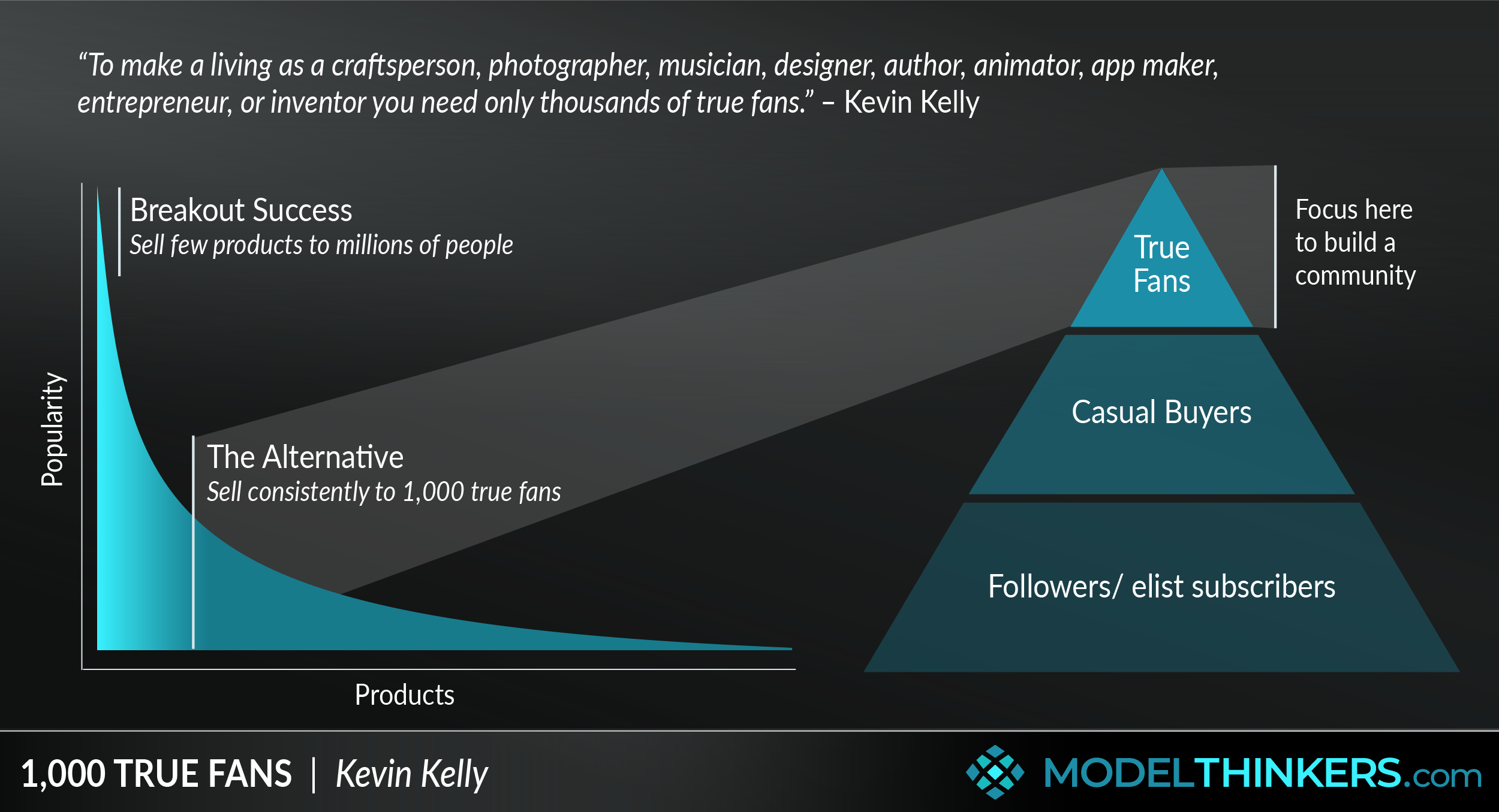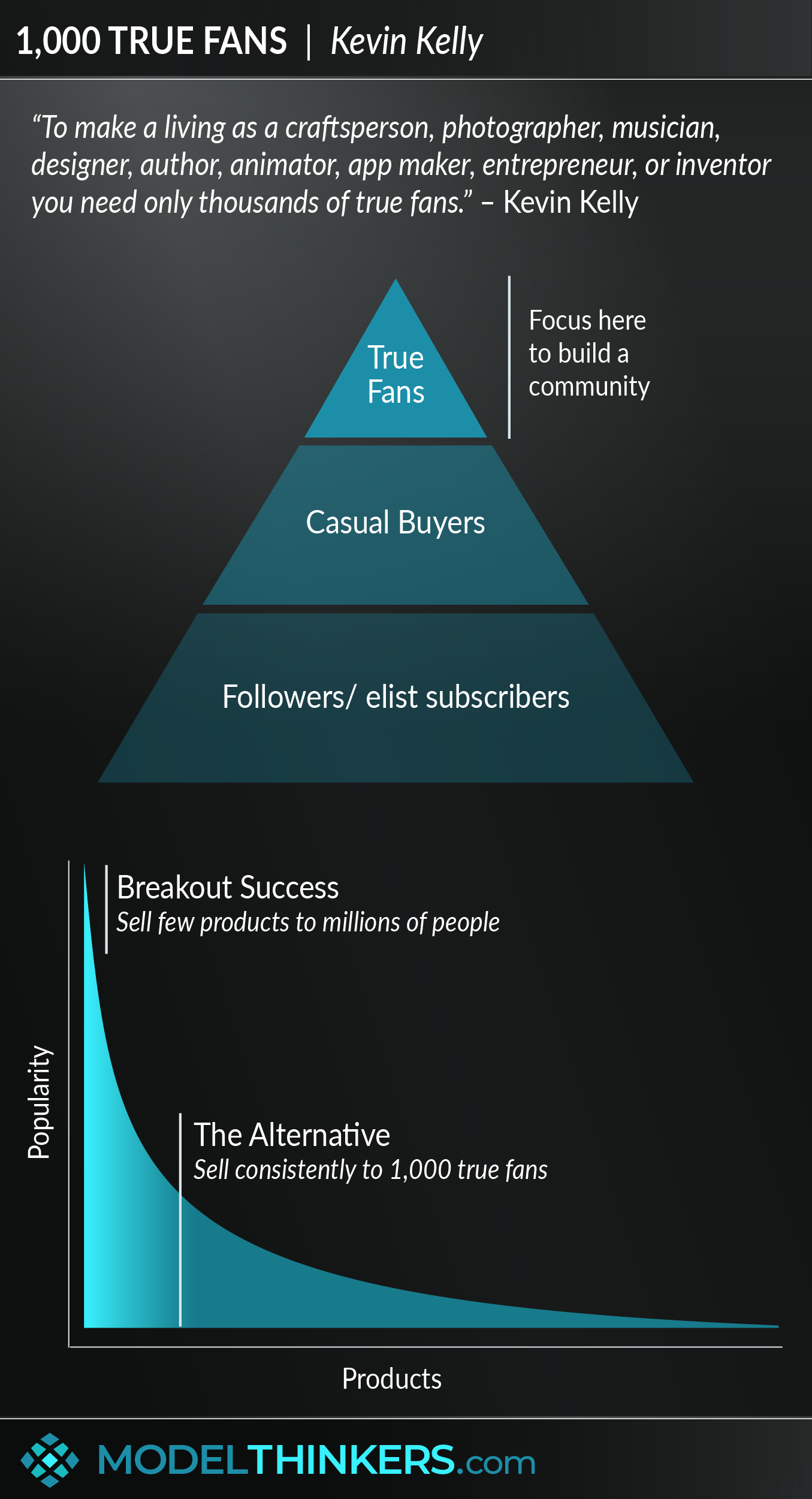

 0 saved
0 saved
 22.6K views
22.6K views








“To be a successful creator you don’t need millions. You don’t need millions of dollars or millions of customers, millions of clients or millions of fans. To make a living as a craftsperson, photographer, musician, designer, author, animator, app maker, entrepreneur, or inventor you need only thousands of true fans.” So begins 'Senior Maverick for Wired' Kevin Kelly’s popular article which inspired this model.
The 1,000 True Fans approach argues that rather than seeking breakout fame and a customer base of millions, creators and entrepreneurs can aim for 1,000 loyal customers who deliver an average of $100/ year profit each.
NOT ALL OR NOTHING.
People pursuing creative and/or entrepreneurial success will generally aspire to celebrities and high profile successes whose efforts, skill, persistence and luck intersected to make them a breakout success. This model suggests an alternative approach of building deeper relationships with a relatively small customer base. The result is a form of ‘micro-celebrity’, where creators are deeply respected by small niche communities — their loyal 'true fans' — but remain anonymous to the broader population. Those true fans are the ones who will engage with and buy almost everything the creator produces.
Kelly points out that: “Early in the rise of the web the large aggregators of content and products, such as eBay, Amazon, Netflix, etc, noticed that the total sales of *all* the lowest selling obscure items would equal or in some cases exceed the sales of the few best selling items.” This Long-Tail Effect is a reminder that smaller, consistent sales of the ‘obscure’ are a rich and undervalued market.
GO DIRECT AND BUILD MEANINGFUL CONNECTIONS.
“Everything made, or thought of, can interest at least one person in a million — it’s a low bar,” Kelly argues. If you achieve that '1 in a million' engagement rate for our global population, it will deliver over 7k people. The trick is, of course, to find and develop deeper relationships with them!
Kelly suggests that traditional corporations and media are ineffective means to connect with niche audiences and instead points to the rise of social media, peer-to-peer networks, and online communities. These trends also allow you to cut out the middleman and create direct relationships which are crucial to shifting someone from a casual buyer to a true fan as well as allowing you to maximise the return from each purchase with fewer commissions or platform costs.
Practically speaking this approach might involve building a social media presence; creating an elist; using patron services; and/or experimenting with crowdfunding as you start to build your community beyond the content you offer. With each option, focus on providing a two-way conversation and empowering your community to connect with each other.
IN YOUR LATTICEWORK.
This model works well in combination with the Surface Area of Luck, and might require you to use the Regret Minimisation Framework to help take the plunge. It’s also worth considering this model in the context of Ikigai to determine the intersection between what you’re good at, what you love, what the world needs, and what you can be paid for.
In terms of building a true fan base and community, you will likely need the Trust Equation, and might want to consider Dunbar’s Number, the IKEA Effect, and the 4Ps of Marketing.




- Stop trying to be famous.
The idea that creatives or even startups need to be the next J.K. Rowling or Google respectively will be unachievable for almost all. Yet it is possible to achieve a sustainable approach with fewer people.
- Focus on direct relationships with 1,000 fans.
Consider how to connect with a relatively smaller group of people who will be passionate about what you provide and loyal buyers of all of your prodcuts/ services. Find them via social media, through crowdfunding, and/or online communities and then invest in your relationships with them.
- Cut out the middleman.
Where possible deliver value and take money from your true fans directly, avoid resellers or middlemen who take a significant cut and also get between you and your ability to build a direct relationship with your fans.
- Help them ‘come for the content stay for the community’.
Rather than just having transactional relationships with customers, aim to engage them with questions, featuring them, and providing meaningful input opportunities for them. In addition, beyond individual relationships with your customers consider how to build a community.
The main criticism of this approach is that it is still very challenging to find 1,000 True Fans, and that there are not many people who can make it work, though perhaps more do so than crack ‘stardom’. Kelly himself has done a follow up investigation of this approach, and his interviews demonstrated the following results.
The above table lists the nature of the artist, their number of True Fans, how much money per year each True Fan contributes and the resulting total income. The percentage indicates how much this contributes to the overall income of the creator, and the years is how long this has been the case.
Even from this small sample, Kelly had to conclude that: “there are very few artists making their entire living selling directly to True Fans. The few that are, are selling high-priced goods, like paintings, rather than low-priced goods like CDs. But there are many that partially fund their livelihood with direct True Fans.” See Robert Rich’s detailed story in the In Practice section for more.
It's likely that the main reason for this challenge is the difficulty in finding those True Fans. Sure, they might be out there and peer-to-peer services are making it easier to find them and connect, but it remains a competitive market, even in niches.
1,000 True Fans in journalism.
This recent article explores implications of this model for journalism. One of the examples includes Matt Kiser’s What The Fuck Just Happened Today site and newsletter which launched in 2017. The article notes: “Just a short time later, the site has secured in excess of 1500 true fans who now contribute more than $14,000 USD / month toward operating expenses. And WTFJHT’s true fans contribute more than just money, they also are responsible for some of the site’s proofreading and copyediting, as well as technical upgrades.”
A reality check from musician Robert Rich.
Kevin Kelly explored a detailed example of 1,000 True Fans with musician Robert Rich here. Robert explained his experience at length in the article, here’s a truncated version which serves as a sobering reality check of what it might take for this approach:
“I agree strongly with your basic thesis [of a thousand True Fans], that artists can survive on the cusp of the long tail by nurturing the help of dedicated fans; but perhaps I can modulate your welcome optimism with a light dose of realism, tempered by some personal reflections.
"The sort of artist who survives at the long tail is the sort who would be happy doing nothing else, who willingly sacrifices security and comfort for the chance to communicate something meaningful, hoping to catch the attention of those few in the world who seek what they also find meaningful. It’s a somewhat solitary existence, a bit like a lighthouse keeper throwing a beam out into the darkness, in faith that this action might help someone unseen.
"Now in my mid-forties, I still drive myself around the country for a few months every year or so, playing small concerts that range in audience from 30 to 300 people. I’m my own booking agent, my own manager, my own contract attorney, my own driver, my own roadie. I sleep on people’s couches, or occasionally enjoy the luxuries of Motel 6.
"So let’s look a bit at the finances. If I can make about $5-$10 per download or directly sold CD, and I sell 1000, I clear a maximum of $10,000 for that year’s effort. That’s not a living. Let’s say, after 20 concerts I net about $10,000 for three to four months worth of full time effort. That’s not a living.
In my case I’m lucky. I can augment that paltry income through some of the added benefits of “microcelebrity” including licensing fees for sample clearance and film use rights, sound design libraries, and supplemental income from studio mastering and engineering fees."
f
The original post entitled 1,000 True Fans appeared on Kevin Kelly’s blog in 2009 and he has since updated it here, though the original article is at the bottom of the post. Kevin Kelly holds the title for 'Senior Maverick for Wired magazine', of which he was a co-founder. His article was extremely popular in its day, and continues to resonate today, and has inspired books such as Superfans.
 My Notes
My Notes
Oops, That’s Members’ Only!
Fortunately, it only costs US$5/month to Join ModelThinkers and access everything so that you can rapidly discover, learn, and apply the world’s most powerful ideas.
ModelThinkers membership at a glance:






“Yeah, we hate pop ups too. But we wanted to let you know that, with ModelThinkers, we’re making it easier for you to adapt, innovate and create value. We hope you’ll join us and the growing community of ModelThinkers today.”






















































































